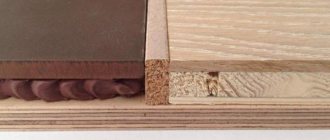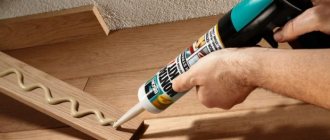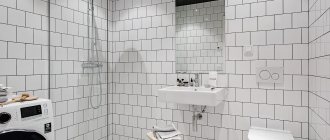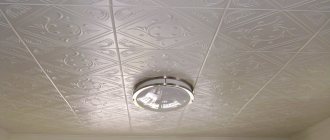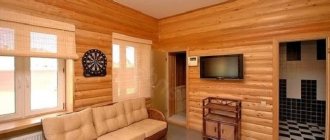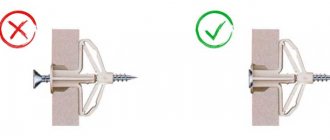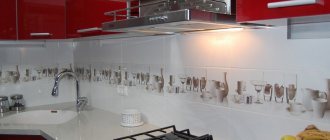A relatively new method of sealing a transition joint involves the use of a special type of sealant. This is a specially developed version of the sealing compound, known as liquid cork, for laminate and tile joints. A very interesting and useful solution, although the attitude towards it is ambiguous. You can make the floor in the kitchen incredibly beautiful and impressive, but if you do not solve the problem of sealing and decorating the joint, the result of so much effort will go down the drain.
Decorative transition from laminate to tile
Methods of joining without a threshold
With changes in temperature and humidity, materials can expand, especially laminate. Therefore, a gap between these materials is required. It must be filled with some elastic material.
Cork compensator
This material is a strip of cork. On one side it can be either painted or covered with a layer of natural wood veneer (in this case the cost is more expensive). The standard length of the material strip is 900 mm, non-standard - from 1200 mm to 3000 mm (on request), width - 7 mm or 10 mm, height - 15 mm, or 18 mm, or 20 mm, or 22 mm. When the joint is located under a doorway, a standard length of material is usually sufficient.
Installation of a cork compensator
Before installation, you need to determine the dimensions of the compensator strip. The height should correspond to the thickness of the floor covering, the width to the width of the gap. The permissible joint width between tiles and laminate is 1 cm.
For installation, do the following:
- clean the edges of tiles and laminate to eliminate cracks and chips;
- remove dirt and dust from the floor;
- coat the gap between the tiles and the laminate with glue;
- place a compensator in the gap, fix the end edge;
- lift the strip from the laminate side and pour in a small amount of sealant;
- remove excess sealant using a wet cloth;
- If the compensator strip protrudes above the floor surface, cut off the excess with a knife.
If the end strip of the cork expansion joint is not covered with veneer, then after the sealant and glue have dried, the end edge should be sanded and varnished.
Grouting joints
The pre-laminated edge is coated with silicone. The same material fills the joint to two thirds. After the silicone dries, the unfilled part is filled with a material called joint grout. After application it should be leveled.
Liquid plug
This relatively soft connector is a sealed material consisting of balsa tree bark chips mixed with a water-based bonding solution. The joint is obtained with the texture and color of cork. Thus, when using this material, three functions are performed: filling the seam, creating a natural and pleasant appearance, and protecting the joint from moisture.
To seal you need to do the following:
- to begin with, you can stick masking tape along the borders of the joint;
- the seam is filled with material either from the tube in which it is packaged, or using a spatula;
- cut off excess, level the surface also using a spatula;
- remove the masking tape with any remaining material;
After this treatment, the liquid plug should dry. This lasts from 24 to 48 hours.
How can you connect the transition?
To neatly design the gap between functional areas, four materials are most often used.
Grout
An easy way to seal winding, shallow seams. Such thresholds are difficult to find, and other fillers will not look so organic. Often in modern interiors there is an interesting way of finishing the floor: polygonal ceramic parts “incline” a little into an area with a different coating. This separates the hallway area from the rest of the house and the kitchen area from the living room. In this case, the transition is also carried out using grout. Do it in the following order:
- Carry out preparatory work.
- Treat the edges of the second material with silicone compound.
- Fill the resulting seam halfway with it.
- Wait for it to dry.
- Dilute the grout, spread it on top and level it with a spatula.
- Wipe the finished dried layer with a damp cloth and cover it with clear varnish to extend its service life.
Photo: Instagram @remont100lvl
Photo: Instagram @remont100lvl
Silicone and acrylic sealant
Joining two sections with elastic sealant is even easier than with grout. The advantage of the method is that there is no need to additionally treat the boards to protect them from moisture. But there is one point - you need to take into account that after drying the filler will turn light brown. The acrylic filler can be painted in a suitable shade after it has dried. Both expansion joints are suitable for renovation work in new buildings, as they are able to adapt to the shrinkage of the building.
Sequence of work:
- Place masking tape on both sides of the seam so you don’t have to waste time scrubbing it off later.
- Make a hole in the silicone paste tube so that it can be squeezed out, or insert it into a special gun.
- Fill the gap so that the sealant extends slightly above the floor surface.
- Use a spatula to remove excess mixture. If you don’t have a spatula, you can wait until the mixture dries and cut off the excess.
Keep in mind that it takes one or two days for the sealant to dry completely. Silicone expansion joints are recommended for use in rooms where the flooring is secured with glue or fasteners.
Photo: Instagram @42m2.ofhappiness
Photo: Instagram @42m2.ofhappiness
Photo: Instagram @42m2.ofhappiness
Photo: Instagram @prinesite_pechenki
Liquid plug
Liquid cork for laminate and tile joints is a moisture-resistant mixture of an adhesive base and cork chips. It has an unusual texture and looks good in seams no larger than 7 mm. On wide crossings it will look alien. This is a simple connection method for areas of any shape.
The hole that is filled with the mass is first cleaned of dust and degreased.
Rules for working with the mixture:
- The coating levels must match. If there is a slight difference, the glue is aligned along the higher edge.
- Do not let the cork get on the floor, as it is difficult to wipe off and, once dry, almost impossible. You can pre-coat the floor with oil or apply masking tape to it.
- The material must be sanded a day after pouring, until it hardens.
The layer turns out to be very durable and it is almost impossible to remove it.
Photo: Instagram @centraparketarf
Photo: Instagram @parquet_design
Cork compensator
One of the most popular ways to design boundaries between two floor coverings. The filler is a soft, pressed lath or whole sheets with the same characteristics. The compensator has several advantages:
- Possibility to choose the appropriate color.
- Ability to withstand building shrinkage and dimensional fluctuations of laminated strips.
- Suitable for wide seams.
- Looks beautiful in the interior.
For this material it is also desirable that both areas are at the same level. Otherwise, the result will not look aesthetically pleasing.
Sequence of working with the filler:
- Adjust the rail to the desired size or cut the part from the sheet.
- Apply adhesive to the entire width of the laminate or tile, and a thin layer of sealant to the bottom.
- Glue the compensator and cover it on top with an antiseptic and clear varnish.
- The rail can be tinted, but you need to take into account that it absorbs paint well and the color turns out saturated.
Photo: Instagram @centrpola.ru
Photo: Instagram @centrpola.ru
Types of thresholds
Such a variety of profiles makes it difficult for property owners to choose. To make this process easier, we recommend that you familiarize yourself with the classification of thresholds for tiles and laminates. They are divided into several categories; we’ll talk about each type in more detail later.
Not every joint can be designed independently: in some cases it is better to delegate the work of finishing the gap to a professional.
According to the profile section shape
In most cases, the latter option is used for tiles and laminate. It supports operation with multi-level floors.
One of the types of threshold used when joining laminate and tiles is called final.
By installation type
There are models of thresholds for porcelain stoneware and laminate that do not require the use of a drill. But as a rule, in apartments the following connecting component is used:
- Steel profile with through fastening. It looks like a special strip with which the joint is covered. A strip of metal presses the edge of the joint to the floor surface. For fixation, self-tapping screws with a hidden head are used. The profile is ideal for decorating different levels of materials or in case of imprecise cutting. It is necessary to seal loose edges with silicone sealant;
- H-shaped design. This variation does not require drilling. To connect, the bottom shelf is inserted behind the panel, after which the tile is inserted into the opposite groove with an adhesive base. The gaps are treated with a special mixture for tiles, and the side of the laminate is filled with a reliable sealant. Very often this is done with acrylic or silicone compounds;
- Demountable H-shaped panel. It is represented by two T-shaped structures, which are fixed to each other using special legs. Once installed, the top decorative piece is placed into the bottom clamp until it snaps into place.
The most common type of cracks that need to be sealed.
The choice of products from this range is based on preferences for the installation method and the type of floor finishing materials.
Such seams are most often finished with the help of additional elements - thresholds.
Based on materials
An equally important aspect of the issue is the raw materials that were used in the manufacture of thresholds for tiles and laminate. Therefore, the quality of the product must be checked before purchase and installation. There are cork products used to connect two different materials. They are more environmentally friendly and expensive. Therefore, they are used in repairs extremely rarely, for example, to decoratively hide small joints.
As a rule, fractures are caused by the fact that the tiles are not trimmed and the laminate is laid end-to-end against them.
There are also rubber, that is, rubber options. The composition includes polymers, which allows for elasticity. But the most popular solutions are steel, aluminum and PVC. We will talk about them in more detail.
This ensures a harmonious appearance of the entire coating.
Metal
Flexible metal profiles are used in wavy curves, but can also be used in straight joints in a room. To ensure resistance to wear, a special powder layer is added to them. It protects products from mechanical damage.
Chrome-plated parts with a mirror coating, which retains its performance properties for many years, have an attractive and impressive appearance.
Aluminum
- with holes for fasteners (screws);
- hidden fastening;
- self-adhesive variations.
High mechanical strength, corrosion resistance, and durability make such products the most popular.
The choice is based on the preferences of the apartment owners and the final result.
Features of various docking devices
Metal joining profile Connections between tiles and laminate are made using products made from different materials, aimed at different customer segments and having their own scope of application. Among these devices, the following should be highlighted:
- Metal profiles (aluminium, brass, steel). These devices are widely used for joining tiles and laminate flooring; they have an affordable price and various color variations. You can choose a profile to match the color of the laminate or the same tone as the door handles. Metal joining is convenient to use on straight connecting sections.
- Plastic strips. This material is the most budget-friendly. It is sold in roll form and can have different shades. It is convenient to use plastic on wavy joints, since the product bends well. Its disadvantages include fragility and loss of appearance after some time.
- MDF moldings.
They fit perfectly under laminate, cover the joint well and have an attractive appearance, but they are afraid of moisture and quickly lose color. Cork expansion joints - Wood products. Widely used to connect wooden flooring to another type of floor. These planks have an excellent appearance and a good price, but require periodic maintenance. The joint needs to be repainted and sanded from time to time to maintain the appearance of the room as a whole.
- Cork compensator. One of the popular modern materials widely used for connecting laminate and tiles. The cork strip fits into the gap between the materials, thereby creating a threshold-free joint that has an excellent appearance and is easy to use.
Some types of butt joints are presented in the table.
It is an adhesive structure into which cork is added, and after hardening the connector looks like a cork expansion joint.
Useful tips
Wood and plastic used as threshold materials wear out quickly. Therefore, it is better to use them in rooms with low mechanical load on the floor surface. In other cases, use metal thresholds.
Aluminum products are the strongest and most durable, but they are not always suitable for the chosen room design.
Despite the fact that wooden sill strips wear out faster, their cost is higher than that of parts made from other materials due to their environmental friendliness and aesthetic value. You should know that wooden thresholds can be either straight or curved.
The most inconspicuous and neat joint is made using a cork expansion joint.
Thresholds for docking not only smooth out differences in level heights, but also prevent debris and dust from getting under the covering.
Installation features
Let us dwell in more detail on the features of each installation method.
Cutting tiles and laminate
If the two materials are joined together with an even seam, then the adjustment is quite easy, but with tortuous areas you will have to suffer a little. First you need to stock up on a template made of cardboard or foam plastic, with which you will mark our joint.
- To perform a curved cut on laminate, you need to have a manual, or even better, an electric jigsaw.
- You can trim the tiles using a grinder or a hand jigsaw. In the first case, you need a diamond disc for tiles, in the second, a diamond string. If there is neither one nor the other, holes are drilled along the cutting line; the larger, the better, and the excess is broken off with wire cutters.
We install flexible PVC profile
- When laying tiles and laminate, you need to try to ensure that there is a gap between them - a place to install the fastening profile. You should also worry about the temperature gap - 5 mm, located near the laminate.
- Using a puncher we make holes for dowels in the expansion joint. If you have heated floors underneath, then it is better to fasten it with liquid nails, and ideally, think through all the nuances in advance when the project is being developed, and, if possible, replace it with another solution to eliminate possible risks.
- We cut the profile to the required length with any tool that is available.
- We connect the fastening profile to the base using dowels.
- The decorative flexible profile must be soft during installation. Therefore, before starting the installation process, we put it in water, the temperature of which is from 50 to 70 degrees, for 20 minutes.
- Finally, insert the decorative nozzle into the profile and snap it into place.
Installing a flexible metal profile
- We check the consistency of the thickness of the coatings (tiles and laminate), taking into account the glue and substrate. They must be identical.
- We bend the profile manually, giving it the desired shape.
- We install the profile simultaneously with laying the tiles. The tile with glue applied to it will firmly press the profile legs to the floor. On the opposite side, it simply includes a laminate with a backing.
- If the tile was laid earlier than the profile, it’s okay, you’ll just have to clean the edge of its edge from the glue so that the profile can freely fall into place.
- When laying laminate, leave a gap of 5 mm. Alternatively, you can lay out one fragment of the covering and simply push it into place, under the profile. It is easier to control the size of the gap if you lay masking tape with markings along the edge of the laminate.
Strengthening the aluminum threshold
To install a regular threshold, perform the following steps:
- cut it, taking into account the width of the door opening;
- mark the drilling points in the place where the joint will be;
- make holes and secure with self-tapping screws;
- We screw in the screws using a screwdriver or a screwdriver operating at minimum speed so that the threshold does not bend.
The correctly cut threshold is trimmed and placed under the trim - there are no gaps left.
We install the threshold with a hidden fastening as follows:
- mark the holes on the base;
- on the underside of the threshold there is a groove into which you need to insert a self-tapping screw and a dowel placed on it;
- drill holes in the floor;
- We install the threshold with dowels into the holes on the floor and carefully hammer it in to the very end. In order for the threshold to remain intact and unharmed, it is necessary to hammer it through a spacer, which can be used as a beam, a piece of board, etc.
Standard fastening is performed using DBM 6x40. A significant disadvantage of such fasteners is the presence of a large gap that forms between the dowel head and the threshold. Therefore, the installation is not reliable. To avoid such troubles, use a dowel measuring 8x60, the head of which is ground off on both sides in advance. This way you can ensure a tighter connection.
The easiest installation is for a threshold that has a self-adhesive base:
- apply the contours of the threshold to the flooring so that its center coincides with the center of the joint;
- Clean the self-adhesive base from the protective film and glue the threshold.
Features and Benefits
If you decide to close the passage without a threshold, you will encounter a problem - the movement of two facing materials. This is especially true for laminate. This is why most people opt for thresholds with gaps and seats for joints.
Modern manufacturers offer a large selection of profiles that differ in material, price and properties. Among sillless technologies, the best choice is the cork expansion joint. It is distinguished by its affordable cost, ease of installation and high quality.
Cork expansion joints are widely used to design the joint between laminate flooring and other materials, for example, floor tiles. The device is a strip of cork that is attached to the joint. After this, it is sanded along with the parquet and coated with a protective varnish. Dirt and dust accumulate in large quantities on unprotected cork material. Also, over time, it often begins to deteriorate and crumble. Therefore, experts recommend not to ignore the moment of varnishing.
Compensators are available in different colors on the market. This allows you to choose the best option that will fit perfectly into the interior of a particular room or other premises.
The compensator is produced in the form of sheets. The buyer independently cuts the strip to the desired width. To do this, you just need a ruler, a pencil and a sharp knife.
Unlike rubber parts and silicone, the expansion joint is guaranteed not to harden over the entire period of operation. Another distinctive characteristic of such a connector is its elasticity. Since the laminated board compresses and expands during use, the expansion joint must also be elastic.
An undeniable advantage of using cork between tiles and laminate is the ability to easily give it any shade using tinting. An important point is also the environmental friendliness of the material. Thanks to this, cork can be safely used in residential premises.
Installing a cork expansion joint yourself is not difficult at all. If you choose the right dimensions, installation will take a minimum of time. With the same ease, even a beginner can dismantle the part without putting a lot of effort into the work.
The compensator parameters can be different:
- standard length is 900 mm, the maximum length of custom-made products is 3000 mm;
- width – 7 mm and 10 mm;
- minimum height – 15 mm, maximum – 22 mm.
Material having a standard length is appropriate to use if the joint is located under the door. In this case, this size will be quite sufficient. In other situations, you will either have to connect several compensators together, or make an individual order.
Options for flooring in the hallway made of tiles and laminate
In the hallway, a combined floor is also often installed - tiles and laminate. There are several reasons for this:
- laminate can look harmonious with the design of the rest of the apartment - hallways often smoothly transition into a corridor, and it should not differ sharply from the rooms where it leads;
- tiles tolerate moisture much better - laminated panels can get wet and begin to bulge, “float in bubbles”;
- “warm floor” in the hallway is a convenient solution for soft drying of shoes and accessories; in the case of tiles, it is much more functional, since it does not emit harmful substances and does not deteriorate from heat.
The main advantages of tiles in the entrance area are their water resistance and ease of cleaning. After a person has taken off his shoes at the entrance, it will be more comfortable for him to switch to a laminate that feels warmer. This is the logic of arranging a combined floor.
In general, for rooms of this kind it is recommended to use lighter coatings and not to use sharp contrasting colors. So, for example, for light-colored tiles (white marble, milky shades) oak, beech, and pine laminates are well suited. On ceramic panels or porcelain tiles in dark shades, dirt and traces of running water will be more visible, while, for example, imitation marble with veins can hide dirt.
Using a cork expansion joint
You can make the joint between the laminated board and ceramic tiles invisible using a cork expansion joint, which is mounted into the laminate.
As for the design, the compensator resembles a directly pressed cork. This material is available in sheet form. The consumer himself can cut the strip to the required width. To do this, it will be enough to arm yourself with a ruler, a pencil and a sharp knife.
Unlike rubber elements and silicone, a cork expansion joint will not harden during operation. Since the laminated board contracts and expands throughout its service life, the expansion joint must also remain elastic.
In addition to being elastic, expansion joints made from cork are resilient. If the laminated board first expanded and then narrowed, then the cork expansion joint will return to its original shape after compression. Rubber elements cannot boast of such quality.
It is also worth noting the natural origin of cork. This allows the use of cork expansion joints in residential premises. Cork is easily painted in any color and can be tinted.
Why do you need to join floor coverings?
When designing modern interiors, zoning of rooms is widely used. It is often created by installing several different floor coverings in one room. For example, the kitchen can be divided into two zones: for cooking and dining. It is better to lay the first one with tiles, the second one with laminate.
Also, with the help of tile and laminate coverings laid within the room, it is possible to visually increase its dimensions. And the successful use of a cork expansion joint will favorably emphasize the features of the room design.
Liquid stopper for joints
When construction, repair, and finishing work is carried out, there is a need to use a building material such as liquid cork, which has noise-insulating and insulating qualities, and is also applicable as a sealant, that is, it does not allow wind, rain, and excess water to penetrate through the window frames during the cold season. sounds This finishing material is also used for decorative coatings.
Not everyone can afford to purchase natural cork for renovation or construction. It is a fairly expensive building material. A good alternative is liquid plug, which is formed from fine crumbs.
Liquid stopper for joints
Advantages of liquid plug
- is environmentally safe;
- has mechanical stability;
- good thermal insulation;
- excellent adhesion to absolutely any surface;
- not susceptible to temperature changes.
This finishing material is quite elastic and does not settle. It can be safely used without any particular fear that the main finish will be damaged. It is successfully used for sealing gaps between coverings, such as walls and parquet, tiles and plastic panels, and laying parquet. Ideally eliminates cracks and evenly presses on parquet boards, which allows you to use the coating without any obstacles.
Using this sealant will also eliminate the unpleasant creaking that may appear in the parquet over time. We can also use this building material for joints between laminate and tiles.
Features of using liquid plug
it is very important to follow the order of laying laminate and other coatings; first lay the tiles, and only then the laminate; when laying floor coverings, the cut line must be straight; When the building materials are properly joined, the cracks are sealed with liquid plug.
Thanks to the effect of this finishing material, the joints that are formed between the coatings will be thoroughly sealed, because it is quite elastic. This sealant is also used as insulation for windows and doors, after which absolutely any drafts will no longer appear in the house.
Since this finishing material contains air, the sealing composition has good thermal insulation properties. This building material is also used as the main one - for treating indoor walls. It is used for both internal and external repair work. The technology for using this sealant is not the most difficult when applying it to walls.
Features of liquid plug
- has the ability not to absorb water, maintains vapor permeability;
- creates a magnificent exterior;
- provides powerful sound and thermal insulation.
The use of building materials in repair work helps eliminate more than one problem that has arisen. Using this material, you have the opportunity to do everything yourself without spending money on calling a specialist to your home.
This sealant significantly reduces street noise and vibration to a level that is acceptable to human hearing. Water vapor, which easily penetrates this building material, improves the microclimate in the rooms. When indoor air humidity increases, steam leaks through the walls to the street, so there is no need to install a ventilation system.
When working with such finishing material, you need to prevent it from getting on open surfaces, because this will complicate the cleaning process. Once the composition dries, this is simply impossible to do. This building material should not exceed the surface of the flooring. It, in combination with construction adhesive, has good resistance to moisture. When using it, there is no need for additional fixation, that is, the use of self-tapping screws.
The permissible seam width for filling joints with building material should be from 5-15 mm, no less. Before applying liquid cork to the cracks, you should remove accumulated debris and dust from them.
In conclusion, we can say that after using this sealant for construction and repair work, even a specialist of the highest class will not regret it.
remontidoma.ru
Purpose
Cork is an original and elastic raw material. Thanks to it, important tasks in the construction field can be solved quite simply, and the products are widely used for the following work:
- providing roof protective covering;
- facade finishing;
- finishing of partitions and ceilings;
- minimizing noise and vibrations;
- thermal insulation;
- anti-corrosion coating of metal structures;
- protection against accumulation of excess moisture;
- sound insulation of carriages, cabins, cars;
- decorative use in the interior;
- protection of low-temperature and high-temperature product pipelines;
- fire protection of various structures;
- insulation of loggias and balconies.
The properties of cork make it possible to use the product for sealing joints between different surfaces and structural materials, for example, between a floor covering and a wall, for finishing joints between tiles and PVC panels, wooden surfaces and laminate. During this work, the seams will be reliably sealed even with large temperature changes, as a result of which deformation of the main composition of the product occurs. This feature is achieved due to the elasticity of the cork.
In addition, this material is successfully used as insulation for door and window openings. Applying liquid cork to the joints of slopes and frames, as well as the seams of the door frame, will eliminate the possibility of drafts in the room.
Liquid cork is a versatile material that finds application as a base material for wall decoration, including indoor and outdoor use.
As a result of its use, a coating is formed that has the following properties and features:
- attractive exterior;
- simple surface application technology;
- water repellency;
- good vapor permeability;
- heat and sound insulation.
The combination of the above properties makes it possible to solve a number of basic problems. First of all, the material eliminates the need to find workers to finish the walls. The processing of the facade or walls in the rooms can be carried out by specialists without serious construction qualifications, which makes it possible to do everything yourself.
In addition, the surface covered with liquid cork looks luxurious and expensive, eliminating the need to purchase expensive finishing materials.
Reliable waterproofing provides high-quality protection from rain moisture, which significantly extends the overall service life of the house. The excellent sound insulation provided by the material solves the problem with street noise, so the maximum proximity to the roadway inside the house will not be felt. Cork perfectly dampens noise and vibration.
Sprayed liquid cork allows water vapor to penetrate through surfaces, which has a beneficial effect on the microclimate inside the house.
When installing high-quality parquet flooring, one of the main points is sealing the joints that appear between the board and the walls. This task is made difficult by the fact that the surfaces have different mechanical properties. Natural wood differs from plaster or tiles in that it can change its geometry due to temperature changes and the effect of moisture on the raw material. Even after a short period of time after installation, parquet may swell or begin to creak due to new formations in the form of gaps. In such cases, it is the liquid coating that will be able to solve such a complex, at first glance, problem.
This is explained by the resilience and elasticity of the cork, which gives the board some freedom. Thanks to this, the material expands, but without compromising the plane of its laying.
The product perfectly fills cracks in parquet due to its elasticity, providing equal pressure on all elements. This is why the formation of gaps is eliminated. At the same time, the material retains excellent strength, which does not limit the possibility of using the coating for its intended purpose. Cork is widely used in parquet repairs as a material for sealing cracks.
Liquid stopper has a variety of applications. Almost anywhere where noise insulation, tightness and thermal insulation are needed, the material will come in handy. Moreover, almost all work with the products can be easily done with your own hands, which will save on paying for hired labor and eliminate the need to purchase expensive materials.
Using Liquid Stopper
An example of applying a liquid compensator using a gun The only mandatory condition for using a liquid compensator is the requirement for surface preparation.
It should be dry and fat-free. It is recommended to treat it with a primer before filling. Liquid linoleum: installation technology and pricing
An ordinary spatula or air gun is suitable as a tool.
Application for construction projects
All reinforced concrete structures and SIP panels have one drawback - under the influence of seasonal changes in temperature and humidity, they are subject to linear fluctuations. Not every sealant is suitable for sealing joints in reinforced concrete structures, since the compounds break down quickly enough and do not have suitable elasticity.
Using polyurethane foam as a sealing agent does not give a positive result, since the foam cracks over time, turns yellow, and after a few years loses its characteristics. Cork sealing compounds are an excellent replacement for polyurethane foam and any specialized mastics. This product is suitable for filling all types of seams, including locking ones, effectively eliminates cold bridges, seals seams and areas adjacent to frame objects. Thanks to these compounds, you can seal joints and seams at home with your own hands; this possibility is relevant for any panel structures.
How to choose?
Types of cork compensator
It is available in solid and liquid form.
Hard material
It consists of strips from 90 cm to 3 m long, up to 10 cm wide and 15-22 m thick. The cork is covered with 7-10 layers of polyurethane varnish, which protects it from exposure to adverse environmental conditions. It is painted in different colors and is used to treat the joint between laminate and tiles. It is made from cork oak bark, which is pressed in special heat chambers. No chemicals or glue are used during the production of the cork expansion joint.
The material is cut into the shape of a narrow sill, which is inserted into the joint between the floor coverings to create a single-level expansion joint. You can use a natural color compensator when sealing joints. In this case, it is tinted in the color that is closest to the coatings. You can also use colored cork expansion joints.
Liquid type of compensator
It is a mixture of elastic cork mass, glue and solvent. Available in 500ml packages, carefully sealed.
The liquid compensator does not shrink and does not delaminate due to high weight load. The liquid plug between the floor coverings helps them move freely. At the same time, increasing or narrowing the laminate does not affect the appearance of the surface. Liquid cork can also be used to eliminate squeaks in parquet flooring by closing the gaps between the slats.
Where is liquid stopper used?
The scope of application of liquid cork compensator is wide. In addition to its main purpose: finishing joints between floor coverings, it is also used in other construction work.
- Liquid cork is indispensable when processing floor seams in recording studios. It has high soundproofing properties, so the work of the studio is not disturbed by extraneous noises and sounds.
- The use of liquid cork expansion joints when sealing seams in partitions between rooms increases sound insulation.
- Liquid cork sealant helps seal cracks when installing windows and doors, helping to retain heat in the apartment and eliminating drafts.
- If the house is panel, then liquid cork also helps to seal the seams between them.
Requirements for using a cork expansion joint
The cork expansion joint gives the transition between two floor coverings a decorative appearance when strict requirements are met in relation to the joint between the laminate and the tiles.
- the edges of the mating sides of the floor coverings must be smooth, without flaws;
- the laminate must be treated with a special agent to prevent moisture from penetrating inside;
- If the tile approaches the joint with the cut side, it is carefully sanded. But no matter how the surfaces are sanded, when joining floor coverings, small micro-cracks are visible that form during the cutting of laminate flooring and tiles. They are filled with sealant. The sealant additionally protects the laminate from moisture;
- The cork expansion joint is cut to height using a sharp construction knife.
Application for thermal protection
When insulating houses and other structures, sealing seams is a mandatory procedure. Creating thermal insulation of joints, seams and various surfaces protects against the occurrence of cold bridges, which could penetrate through hidden places and areas. Thanks to the reliable and strong adhesion of the cork sealant to the base, a monolithic, durable joint is formed.
The sealing agents have optimal fluidity and plasticity, due to which they penetrate even the smallest cracks, joints and defects, are very easy to apply and are simply smoothed out with a regular spatula. When the composition is used to seal joints of laminate or other finishing materials, it perfectly levels out any unevenness and roughness and makes the surface visually attractive. After hardening, the product can be tinted or painted.
When is liquid stopper used?
Manufacturers also offer a compensator in the form of a liquid mixture. The liquid plug between the two facing materials allows the coating to move freely. At the same time, the expansion and contraction of the laminate does not affect the appearance of the surface.
Liquid cork is used to close gaps in parquet flooring, remove squeaks and restore the floor to its original appearance. It is successfully used not only for parquet, but also for places where it is necessary to install protection from noise and high humidity, while retaining heat.
No special skills are needed to work with liquid plug. The main thing is to adhere to the basic requirements (clean the surface of dirt and dust, dry it and treat it with a primer).
However, liquid plug also has disadvantages. After installing it in the room, you will have to do a general cleaning.

